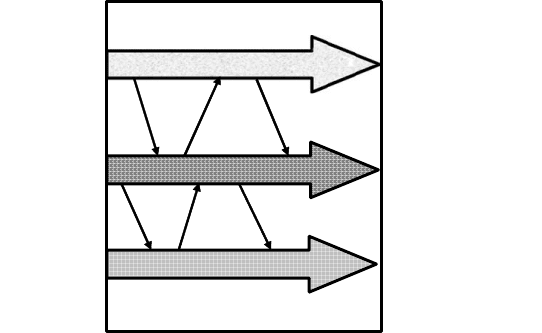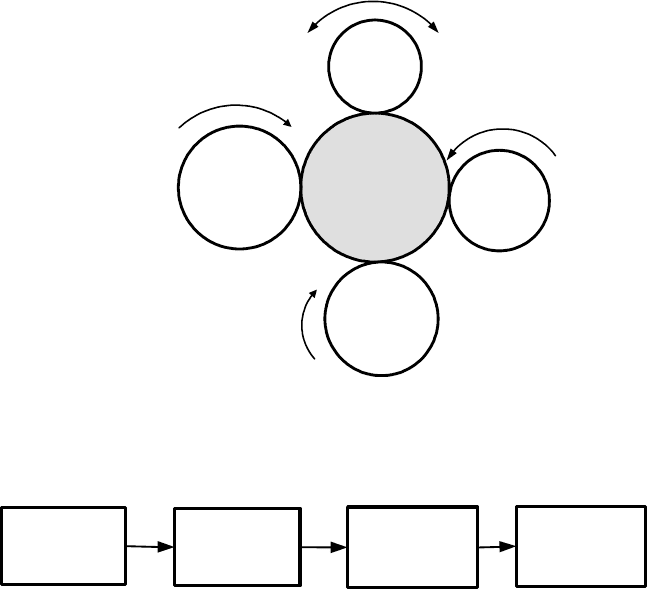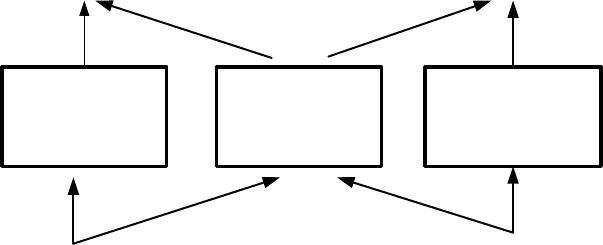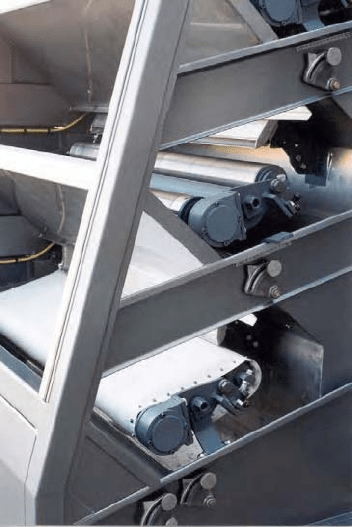Jan Svoboda. Magnetic Techniques for the Treatment of Materials
Подождите немного. Документ загружается.

This page intentionally blank
Chapter 7
Innovation and future
trends in magnetic
techniques of material
treatment
7.1 Introduction
In the last two decades the mining and metallurgical industries have been ad-
dressing a variety of economic, environmental and social challenges through
numerous technical and management programmes. These programmes include
conservation of resources using more e!cient mining and treatment processes,
impounding and isolating wastes to minimize deterioration pending the day
when economic use is found for these minerals, and facilitating the recycling
of scrap and various types of wastes. These objectives of sustainable develop-
ment can be met only if the mining and metallurgical operations employ the
best available technology, improve energy e!ciency and use renewable energy
resources.
In forecasting future developments in material treatment, two approaches
may be taken [A45]: the first one is a simple extrapolation from the present. The
second approach is based on a long-term vision, on establishment of technology
strategies and the timely identification of emerging science and technology.
If the first avenue is used, it appears that nothing really innovative can be
expected during the next twenty years. The second, more risky avenue, is likely
to produce some significant future developments as a result of the emergence
of breakthrough technologies. Breakthrough, or ’disruptive’ technologies based
on intelligent materials, ceramics, nanostructured materials, high-temperature
superconductors and others can allow mineral processing, and material treat-
ment in general, to develop new processes and to explore future resources such
551

552 CHAPTER 7. INNOVATION AND FUTURE TRENDS
Development
Knowledge
Research
Innovation
Prototype or
Opportunity
$ improvement or
New business
Figure 7.1: A possible connection between research, development and innovation
(adapted from [B47]).
as deep-sea and extraterrestrial minerals. It is currently being speculated [W35]
that it is possible to expect that significant developments will arise at all scien-
tific and engineering levels in the next two decades.
The future of mining companies is thus based on sustainable competitive ad-
vantage in the changing and increasingly turbulent environment and continuous
innovation is key to achieving this. The introduction of new technologies into
the mining and mineral processing operations is, therefore, a strategic necessity.
This necessity does not always appear to be part of strategic plans of major
players in the minerals industry. It is often claimed that although even suc-
cessful mineral companies are slow to adopt new research results, they are good
at innovation [B47]. This view seems to contradict observations that many of
the past innovations have actually come from the smaller, more entrepreneurial
organizations. In addition, many of the large mining and processing companies
are cutting back on their own research & development capabilities [N14, S96,
B49].
7.2 Science and technological innovation
It is often argued, for example, by Batterham [B47], that research, development
and innovation are separate processes. It is claimed that whilst the connections
between these processes are frequent, as is illustrated in Fig. 7.1, they are on an
’as required’ basis. It is even claimed that innovation can proceed without any
research and development and it is innovation that generates the competitive
advantage, not research or development per se [B47].
The view that research, development and innovation are separate often meets
with strong disagreement in R&D circles [J10]. It also seems to contradict

7.2. SCIENCE AND TECHNOLOGICAL INNOVATION 553
Innovation
R&D
Ideation
Implementation
Introduction
Invention
Opportunity
Marketing
Engineering
and
manufacture
Figure 7.2: The elements of innovation (adapted from [R29]).
Basic
research
Applied
Research
Development
Production
and
operation
Figure 7.3: A linear model of scientific advances.
the actual history of science and technology. It can be postulated, and well
supported by practical observations, that innovation is the process by which
the invention is first brought into use [G28]. It involves the improvement or
refinement of the invention, the initial design and production of prototypes,
pilot plant testing and construction of production facilities. Innovation can be
looked upon as the total process from the inception of an idea through to the
manufacture of a product and finally to its ultimate application resulting in
profit. It therefore includes invention and the many stages of implementation
such as research, development, production and marketing [B48], as is illustrated
in Fig. 7.2. In other words:
Lqqrydwlrq = Lqyhqwlrq + H{sorlwdwlrq
In this equation invention is the generation of new knowledge, while innovation
is the application of new knowledge for a purpose.
This dynamic non-linear model is in contradiction with the traditional linear
model of research, development and technology transfer, a sequence of processes

554 CHAPTER 7. INNOVATION AND FUTURE TRENDS
Pure basic
research (Bohr)
Pure applied
research
(Edison)
Use-inspired
basic research
(Pasteur)
No
Yes
Consideration for use?
Yes
No
Quest for
fundamental
understanding?
Figure 7.4: The quadrant model of scientific research (adapted from Stokes
[S95]).
extending from basic research to new technology, as depicted in Fig. 7.3. This
model is based on the belief that scientific advances are converted to practical
use by a one-way flow from science to technology and that basic advances are
the principal source of technological innovation. It thus transpires from this
paradigm that each of the successive stages depends upon the preceding one.
This concept of a one-way linear flow is, however, in conflict with the history
of science and technology and today has largely been abandoned [T13]. There
are ample examples of the reverse flow from technology to science [S95] and it is
no longer believed that pure, curiosity-driven basic science will itself guarantee
the technology required to maintain competitive advantage.
It is also not possible to draw a sharp line between basic and applied research,
as work directed toward applied goals can be highly fundamental in character.
In order to take into account such a synthesis of the goals of understanding and
of practical use, Stokes [S95] proposed a quadrant model of scientific research
illustrated in Fig. 7.4.
The second quadrant (the upper left-hand cell) includes basic research that
is guided solely by the quest for understanding without thought of practical use.
Stokes called it Bohr’s quadrant to illustrate how much Niels Bohr’s quest of a
model atomic structure was a pure voyage of discovery.
The fourth, Edison’s, quadrant (the lower right-hand cell) includes research
that is guided solely by applied goals without seeking a more general under-
standing of the phenomena of a scientific field.
The first quadrant in the upper right-hand cell includes basic research that
seeks to extend frontiers of understanding but is also inspired by consideration
for use. Or, conversely, it includes goal-orientated research which, due to its
complexity, requires investigation of its fundamentals. Stokes called this section

7.3. MAGNETIC SEPARATION AND INNOVATION 555
Pure basic
research
Use-inspired
basic research
Purely applied
research and
development
Improved
understanding
Improved
technology
Existing
understanding
Existing
technology
Figure 7.5: A dynamic model of science and innovation (adapted from Stokes
[S95]).
Pasteur’s quadrant to reflect Pasteur’s drive towards understanding.
The history of science and technology is replete with examples of research,
inventions and innovations that were directly influenced both by the quest for
general understanding and by considerations of use. It follows from the analysis
of these examples that the linear model that saw the advances of science as
fully determining the development of technology must be replaced by a model
that reflects the dual interactive character of basic and applied research and
innovation. Such a model is shown schematically in Fig. 7.5.
Industrial magnetism is the scientific and engineering field that is particu-
larly flush with such examples. Development of modern permanent magnetic
materials, ferrofluids, magnetic carriers and of high-temperature superconduc-
tors are just a few examples of investigations undertaken either to gain new sci-
entific and technical knowledge, directed primarily towards a specific practical
aim or objective, or to furnish fundamental understanding of existing empirical
knowledge.
7.3 Magnetic separation and innovation
Methods of treatment that use magnetic force oer a unique approach to mate-
rial manipulation in a wide spectrum of industries. One of the main advantages
of material treatment in a magnetic field is that this additional magnetic force
can be applied in a controlled manner, in a wide range of values. Moreover,
this force can be superimposed on other physical forces and several physical
properties of materials can thus be exploited simultaneously.
556 CHAPTER 7. INNOVATION AND FUTURE TRENDS
In addition, magnetic separation in general can treat a wide range of types
of materials, ranging from colloidal to large sizes and from "non-magnetic" to
strongly magnetic. Magnetic separation is an environmentally friendly technique
and it can operate in wet and dry modes, making it a technique of choice in
arid and arctic regions.
7.3.1 Reliance on an empirical approach?
In spite of considerable progress, magnetic separation has not, so far, developed
to its full potential. The fundamental problem appears to be a gap between
scientific understanding and the engineering of this technology. Although nu-
merous rigorous descriptions of assorted magnetic separation techniques have
been introduced, their applicability to complicated engineering operations has
been limited. Insu!cient understanding of engineering practices, failure to ap-
preciate the scale-up problems and incorrect assumptions often resulted in dis-
appointments and sometimes in financial losses. Such a scenario has not helped
to promote new technological advances in a conservative mining industry, which
is slow in adopting new research results [A45, B47].
The production-scale innovation in magnetic methods of material manip-
ulation has, therefore, been often left to plant engineers who had to rely on
intuition and the empirical approach rather than on a working knowledge of the
principles of magnetism. In 1975 Henry Kolm [K7] felt that physicists would
have to learn more about mining because they were not likely to teach miners
enough about magnetic technology.
It is doubtful whether this proposition has been implemented. It appears
that only limited progress has been made in bridging the gap between "high
technology" and "low technology" since the time when this challenge was iden-
tified [K7, S1]. This gap and lack of interaction among the many disciplines
comprising magnetic separation has been delaying a progress in the application
of sophisticated magnetic technology to the challenges facing magnetic separa-
tion. This is in spite of enormous progress in the development of new magnetic
materials, modelling software and magnet design [S97].
7.3.2 A walk through innovation in magnetic separation
The innovation milestones
During the last fifty years of the 20th century, magnetic separation evolved
from a simple technology to manipulate strongly magnetic coarse materials into
a powerful technique for the treatment of weakly magnetic, finely dispersed
particles. This is the result of development of high-intensity and high-gradient
magnetic separators that used either resistive or superconducting electromag-
nets, or even permanent magnets.
As has been discussed in Section 1.1, the development of permanent magnetic
materials and an improvement of their magnetic properties, particularly during
the last thirty years, has been one of the main drivers of innovation in magnetic
7.3. MAGNETIC SEPARATION AND INNOVATION 557
separation. The history of improvement in the energy product of permanent
magnets is illustrated in Fig. 1.1.
Introduction of ferromagnetic bodies, or the matrix, into the magnetic field
of a separator, in order to increase the field gradient and thus the magnitude of
the magnetic force, was another significant driver that resulted in the develop-
ment of sophisticated magnetic separators. This innovation extended the range
of applicability of magnetic separation to many weakly paramagnetic or even
diamagnetic materials of micrometer dimensions.
Introduction of superconductivity to the minerals industry is a significant
milestone not only for magnetic separation but also for superconductivity it-
self. Although numerous superconducting magnetic separators are operating in
mineral beneficiation plants, the potential of superconductivity still remains to
be fully developed. The generation of a high magnetic field and high magnetic
force, in large volumes, elimination of matrices, reduction in energy consump-
tion, introduction of high-temperature superconductors, are some areas where
superconductivity can become truly a breakthrough technology.
The role that these milestones played in an eort to improve the magnetic
separation technique can be illustrated by numerous examples. The reasons for
success or failure can also be identified.
Implementation of innovation: successes and failures
The reasons for failure to implement successfully a new technology often do
not lie with the technology itself, but with the work system into which the
technology is introduced [M44]. For instance, a new technology could have been
technically too advanced for the level of skills available, or it may have required
too radical a change in the way work was done. Possibly the need for a new
technology was not strong enough. The cost might have been too high or it
might have encountered resistance from the workforce. Premature application
of an unproven technology, exaggerated expectations raised by an overzealous
supplier and fear of job loss as a result of a new technology are additional factors
that increase the risk of failure.
A review of the innovation landscape in magnetic separation shows that
enormous eort has been expended over the years in order to convert a wealth
of novel ideas into workable techniques and to introduce them into the material
treatment operations. Successes and failures are almost equally represented in
this process and they can serve as a lesson for future endeavours to introduce a
new technology into the material processing industries [S96, S98].
Advent of rare-earth permanent magnets
One of the most successful innovations in magnetic separation resulted from the
development of powerful rare-earth permanent magnets. An induced magnetic
roll separator described in Section 2.3.2 and in Figs. 2.25, 2.26 and 7.6, has been
traditionally used to treat dry weakly magnetic materials. There are several

558 CHAPTER 7. INNOVATION AND FUTURE TRENDS
Figure 7.6: Carpco induced magnetic roll separator (courtesy of Carpco-
Outokumpu Technology).
technical limitations to IMRs, namely a relatively low capacity per unit length
and limited particle size range.
With the advent of rare-earth permanent magnetic materials it became pos-
sible to construct magnetic rolls that generate a magnetic field, gradient and,
therefore, a magnetic force that exceeds that produced by an IMR separator.
Although the magnetic field cannot be easily varied in such rolls, by a judicious
selection of the permanent magnet material and of the thickness of the belt,
and by optimizing the geometrical configuration of such a roll, it is possible to
design rolls for treatment of materials of dierent size ranges and magnetic
susceptibility distributions.
In addition to significantly lower energy consumption, there are numerous
other advantages compared to an IMR. A permanent magnetic roll separator,
shown in Figs. 2.30 and 7.7, has significantly lower mass and size. The absence
of an air gap means that large particles, for instance as big as 25 mm or more,
can be treated. A magnetic scalping stage is not needed since the belt detaches
and easily discharges any strongly magnetic particles.
The considerable technical and commercial success of permanent magnet
roll separators is a result of two factors. The first is the availability of a large
variety of magnet grades and sizes, as well as decreasing cost and improved
quality of the magnet material, particularly in terms of the energy product
and thermal stability. The second aspect that played the decisive role is the

7.3. MAGNETIC SEPARATION AND INNOVATION 559
Figure 7.7: A permanent magnetic roll separator (courtesy of Roche Mining).
improved engineering reliability, such as better quality of belts, their tracking
and an ease of replacement. At the present time, permanent magnetic rolls are
manufactured by a variety of firms and are employed in a wide spectrum of
mineral and chemical industries.
High-gradient magnetic separators
The introduction of a matrix into the circuits of magnetic separators resulted
in a dramatic extension of the applicability of magnetic separation to materials
that were previously considered too fine or too feebly magnetic. This signifi-
cant development was achieved by Jones [J1] who combined Frantz’s idea [F35]
of a magnetized matrix with a high magnetic field of optimized orientation.
The magnetic force was thus increased by several orders of magnitude. This
idea initiated a long period of detailed academic research on the one hand and
heuristic development on the other. This eort has been characterized by some
remarkable achievements and, at the same time, disappointments.
High-gradient magnetic separators based on Jones’s concept use electromag-
nets with an iron yoke to produce the magnetic field. For large-scale applica-
tions this approach suers from two fundamental drawbacks. The maximum
